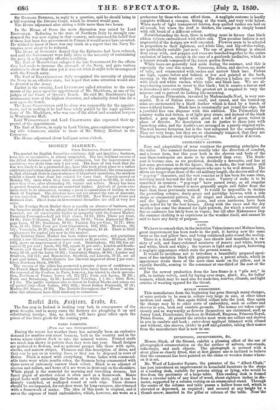Rstful 3rts, fashions, Oratio, kr.
The flax crop in Ireland is looking very bad, in consequence of the great drought, and in many cases the farmers are ploughing it up and substituting turnips ; this, no doubt, will have great effect upon the prices of fine linen goods for the coming year.
PARIS FASHIONS.
(From our own Correspondent.)
During the recent hot weather there has naturally been an exclusive demand for muslins and straw bonnets, both in the country and in the towns where visitors flock to take the mineral waters. Printed stuffs are much less showy in pattern than they were last year. Small designs are preferred to flowers, and no patterns prosper like those with spots, checks, and narrow stripes. Flounces suit this description of dress, and they can be put on in waving lines, or they can be disposed in rows of threes. Black is mixed with everything. Some ladies with commend- able taste wear white muslin robes, the flounces being ornamented with three rows of extremely narrow black velvet. Black is an adjunct of sleeves and collars, and bows of it are worn in front and on the shoulders. White pique is the material for morning and travelling dresses; but fancy piqué of another colour is often used as a framework. Maize piqué looks well encircling the bottom of a white skirt, and it can be sharply vandyked, or scalloped round at each edge. These dresses should be accompanied, for out-door wear, by long casaques, also trimmed with a framework of maize. The idea of this mode is original, and it saves the expense of braid embroideries, which, however, are worn as a preference by those who can afford them. A negligee costume is hardly complete without a casaque, fitting at the waist, and very wide below. When made of light transparent fabrics, deep quilled ruches are laid on all round, but when the stuff is thicker, the caaaque is simply bound with silk braid of a different colour.
Notwithstanding the heat, there is nothing more in favour than black ribbon velvets embroidered with white silk. This peculiar fashion is not ungraceful if the designs are well executed. Flowers seem to be selected in proportion to their lightness, and white lilac, and lily-of-the-valley, are particularly suitable just now. The use of green foliage is almost done away with, and poppies and roses are bunched together to the entire exclusion of leaves, except in the case of a g-uirlande jardinière, which is a bonnet wreath composed of the rarest garden flowers.
White laces are generally laid aside during the summer, and this is especially the case this season. Canezous, fichus, and sleeves, are made of tulle, and ornamented with ruches and narrow black lace. Fichus are high, square before and behind, or low and pointed at the back, crossing in the front without ends. The sleeves h ballon are covered with black and white ruches, white tulle and black lace. We are al- ways having occasion to recur to this black ; but it creates a fureur and is introduced into everything. The greatest art is required to vary the mixture and to prevent its looking like mourning. Le chapeau Piemontais, invented by Mademoiselle Noel, is very suc- cessful. It is of Italian straw, small, and round, and the turned-up sides are surmounted by a black feather which is fixed by a bunch of roses without leaves. Black lace is occasionally put round the edge, but a youthful face can dispense with this addition. The Piemontais for country walks and drives, is of light grey straw, and instead of the black feather, a grey one tipped with green and a tuft of green velvet in place of flowers. No description can do justice to these hats with turned-up sides, and the feathers are arranged in a purely original style. The well known fornarina hat is the best safeguard for the complexion. They are very large, but they are so charmingly trimmed, that they are
becoming to almost every description of face. LEONIE d'AUNET.


























 Previous page
Previous page